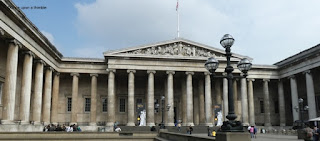 |
| The British Museum (BM) |
Our first speaker was the Curator of the Horological Collection who showed us examples of small clock finds in the ground. They cannot clean them up because they would disintegrate but they do use X-rays, which tell them a lot. Watches were first made in the 1500s, which I did not realise .
'Treasure' can be different things - precious metals like gold and silver, or large quantities of coins.
 |
| About 2" across with gold rings on the points |
This is a 5,000 year old Bronze Age 'bulla' made of gold! Double click on the photo to see the intricate construction made without the tools we use nowadays. Mind blowing.
 |
| Axe heads |
These were found in South Wales, date 875-800BC. They could have been buried by a metal worker.
These two photos are a copper alloy strap end, with two silver rivets (hence they are treasure) and are from the 9th century. I love this face and makes me smile.
This beautiful item is gold with garnets set into it and is part of a sword pyramid.
I have been to Sutton Hoo but never seen the helmet before.
So ended an informative training day, but not before I had booked myself onto a conference for PAS volunteers later in June, also at the BM!!
For anyone wanting to see crafty things, my apologies but during summer months these get pushed onto the back burner and also because this week I am looking after my younger son's dog so plenty of walks and exercise both for him and me. Our local countryside at its best.
This item is a silver barbel for hawks made by Will Englefield in the 17th century. It is tiny.
We were also shown a gold Roman finger ring that I photographed but cannot show because it hasn't been to the Coroner yet!!
Next stop was the museum's Coins and Medals Collection, but no photography here at all. It was a numismatist's dream with racks of coin boxes and we were shown different Roman coins. The UK has the best database in the world for coins as we record the best. We were shown Roman gold coins found by a river bank in Kent that could have been buried by a soldier on his way to the North and never coming back for it, as well as coins from the Hoxne Hoard
After this we had a gallery tour of the BM and actually saw how the Hoxne Hoard was found.
We were also shown a gold Roman finger ring that I photographed but cannot show because it hasn't been to the Coroner yet!!
Next stop was the museum's Coins and Medals Collection, but no photography here at all. It was a numismatist's dream with racks of coin boxes and we were shown different Roman coins. The UK has the best database in the world for coins as we record the best. We were shown Roman gold coins found by a river bank in Kent that could have been buried by a soldier on his way to the North and never coming back for it, as well as coins from the Hoxne Hoard
After this we had a gallery tour of the BM and actually saw how the Hoxne Hoard was found.
So ended a brilliant day out, but before I left I had to visit this collection -
 |
| The original helmet from the Sutton Hoo collection |
 |
| A reconstruction of the helmet |
So ended an informative training day, but not before I had booked myself onto a conference for PAS volunteers later in June, also at the BM!!
For anyone wanting to see crafty things, my apologies but during summer months these get pushed onto the back burner and also because this week I am looking after my younger son's dog so plenty of walks and exercise both for him and me. Our local countryside at its best.

























